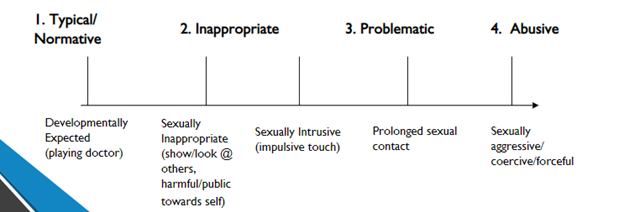Children in foster care are removed for many different types of abuse and neglect. Sexual abuse is unfortunately very common to see.
Within the general population, this statistic is staggering but in foster care that number is even higher
1 in 4 girls will be sexually abuse before their 18th Birthday
1 in 6 boys will be sexually abused before their 18th Birthday.
There are many facets of sexual abuse. 90% of perpetrators are known to the child. It is believed less then 6% of child sexual abuse is reported to the police and less than 10% of those convicted of felony child molestation are imprisoned.
34.2% of perpetrators are family members
58.7% of perpetrators are acquaintances
What is Sexual Abuse?
According to the U.S. Department of Health and Human Services, child sexual abuse generally refers to sexual acts, sexually-motivated behaviors, or sexual exploitation involving children. It can happen to children of all ages, from infants to teens. Sexual abuse is also defined as conduct harmful to a child’s mental, emotional, or physical welfare.
Sexual abuse includes nonconsensual sexual activity between an adult and a child/minor or between children of any age. In Texas, the legal age of consent is 17 years old. Child sexual abuse also occurs when an adult, child, or minor teen uses a child to gratify sexual desires.
What are the signs that is has occurred?
There are physical, behavioral, and emotional signs that a child has experienced sexual abuse, often causing a combination of the symptoms below:
BEHAVIORAL
Increase in nightmares – Sleeping difficulties – Withdrawn behaviors – Angry outbursts – Unexplained health problems – Loss of interest in school –
Increase in nightmares – Sleeping difficulties – Withdrawn behaviors – Angry outbursts – Unexplained health problems – Loss of interest in school –
Increase in nightmares – Sleeping difficulties – Withdrawn behaviors – Angry outbursts – Unexplained health problems – Loss of interest in school –
Self-harming behaviors – Not wanting to be left alone with a particular individual – Sexual knowledge that is inappropriate for child’s age – Regressive Behaviors – Using new words describe body parts (especially ‘cutesy names’) – Change in eating habits –
Self-harming behaviors – Not wanting to be left alone with a particular individual – Sexual knowledge that is inappropriate for child’s age – Regressive Behaviors – Using new words describe body parts (especially ‘cutesy names’) – Change in eating habits –
Self-harming behaviors – Not wanting to be left alone with a particular individual – Sexual knowledge that is inappropriate for child’s age – Regressive Behaviors – Using new words describe body parts (especially ‘cutesy names’) – Change in eating habits –
PHYSICAL
Sexually Transmitted Infections (STIs) – Signs of trauma to the genital area – Unexplained bleeding or bruising on the genital area – Blood on sheets or underwear –
Sexually Transmitted Infections (STIs) – Signs of trauma to the genital area – Unexplained bleeding or bruising on the genital area – Blood on sheets or underwear –
Sexually Transmitted Infections (STIs) – Signs of trauma to the genital area – Unexplained bleeding or bruising on the genital area – Blood on sheets or underwear –
EMOTIONAL
Change in mood or personality – Increased aggression – Decrease in confidence or self-image – Excessive worry or fearfulness – Anxiety – Depression –
Change in mood or personality – Increased aggression – Decrease in confidence or self-image – Excessive worry or fearfulness – Anxiety – Depression –
Change in mood or personality – Increased aggression – Decrease in confidence or self-image – Excessive worry or fearfulness – Anxiety – Depression –
Spectrum of Sexual Behaviors
There is a widely believed myth that children who are sexually abused are more likely to become a sexual abuser. This is not true. There is a spectrum of sexual behaviors.

Most children who were sexually abused fall between typical sexual behavior and inappropriate reactions with impulsivity. This is mostly due to having too much knowledge about sex. But children who receive counseling and safe adults to teach them appropriate ways of keeping themselves and others safe, are likely to cease the inappropriate behaviors in time.
The way to determine if it is considered sexual abuse is if the following behaviors are involved:
- Less powerful – Differences in developmental level, physical stature, cognitive ability, or social skills.
- Seduction – The use of charm, manipulation, promises, gifts, and flattery to get a person to engage in sexual behavior.
- Coercion – Abusing authority or using bribes, threats (including threats of force), or intimidation to gain cooperation or compliance.
- Force- Threat or use of physical or emotional harm toward a person, or something or someone the person cares about.
Teaching Body Safety
There are many ways to teach children body safety early on. Having regular conversations with your children about their body, consent, and boundaries helps open up the relationship for safe communication. There are many children books that address this in kid-friendly ways. When children are able to identify safe touch, then they will be able to communicate if something happens that is not a safe touch.
Another resource for tools to keep your children safe: https://www.allianceforchildren.org/child-abuse-prevention-month
If you suspect sexual abuse of a child, you are mandated to report to the Texas Abuse/Neglect hotline (1-800-252-5400) or https://www.txabusehotline.org/
Written by Staci Beck




